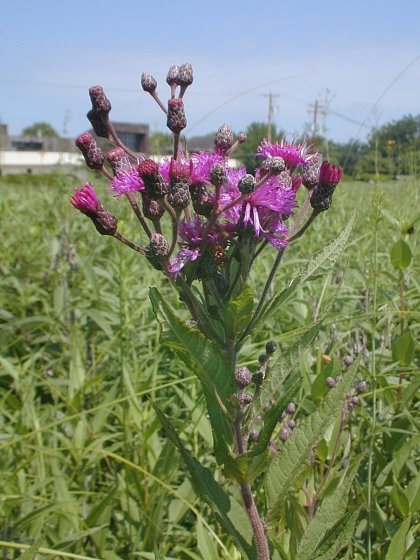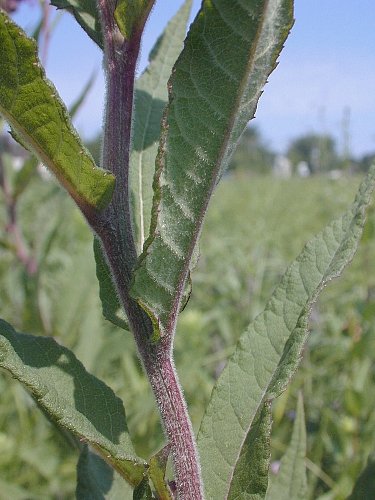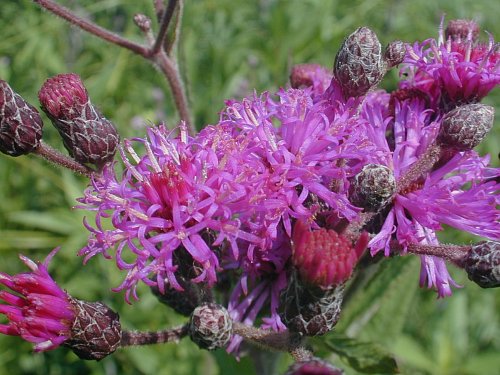Description: This perennial plant is 3-6' tall and unbranched, except for the flowering stalks of the inflorescence. The central stem is stout and covered with fine white hairs. The alternate dark green leaves are up to 7" long and 2" across. They are lanceolate to narrowly ovate, and slightly serrrated along the margins. The lower sides of the leaves are covered in dense white hairs, which are longer and more prominent than other Vernonia spp. At the apex of the plant, the inflorescence is a corymb of numerous rayless composite flowers. The hairy stems of the inflorescence are usually reddish brown. Each composite flower is about ½–¾" across, and contains from 30-60 disk florets (usually closer to the lower end of the range). These florets are bright magenta and quite showy. There is no floral scent. Numerous dull green or reddish brown bracts subtend the composite flowers, which are aligned together like fish scales. The blooming period occurs from late summer to early fall, and lasts about a month. The root system is densely fibrous and rhizomatous, and will form offsets to create a small colony of plants. The ribbed, slightly hairy achenes have a small tufts of light brown hair, and are dispersed by the wind.

Cultivation:
This
plant prefers full or partial sunlight and moist to average conditions.
It is somewhat drought resistant. Under severe conditions, the plant
will wilt and blooms abort. The soil texture can consist of fertile
loam, clay-loam, or have a slightly gritty texture from exposed glacial
till and gravel. Disease is not troublesome, except for occasional
episodes of mildew during the fall. This species is easy to grow.
Range & Habitat:
The native Missouri Ironweed occurs throughout Illinois, except in the
NW corner
of the state (see Distribution
Map). It is a common plant. Typical habitats include moist to
mesic black soil prairies, openings and edges of woodlands, swamps,
seeps, limestone glades, edges of lakes, overgrazed pastures, vacant
lots, and areas along railroads. It is common in disturbed areas, but
also occurs in high quality habitats.

Faunal Associations: The flowers attract long-tongued bees, butterflies, and skippers primarily. Among the bees, are such visitors as bumblebees, Epeoline Cuckoo bees, and Miner bees. Butterfly visitors include Swallowtails, Whites, Sulfurs, Monarchs, Painted Ladies, and others. Bee flies and Halictid bees may also visit the flowers. The flowers are capable of self-pollination in the absence of these insects. The caterpillars of some moths feed on Ironweed species, including Grammia parthenice (Parthenice Tiger Moth), Perigea xanthioides (Red Groundling), and Papaipema cerussata (Ironweed Borer Moth). Mammalian herbivores avoid consumption of this plant because of the bitter taste of the leaves. In overgrazed pastures, Ironweed is an 'increaser' because it is one of the last plants to be eaten.

Photographic
Location: Photographs
were taken at the Red Bison Railroad Prairie in Savoy, Illinois.
Comments:
This is an attractive plant when in bloom, and one of the best
attractors of late summer butterflies. Missouri Ironweed can be
distinguished from other Vernonia spp. primarily by
the number of disk florets in the compound flowers, and the profuse
hairiness of the stems and lower sides of the leaves. It is probably
the most common species of ironweed in Illinois. Sometimes hybrids
occur among different species of ironweeds, making identification
difficult.